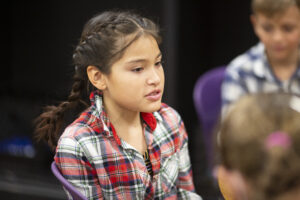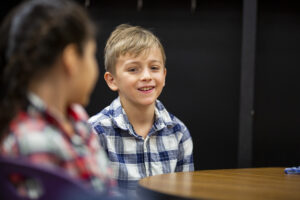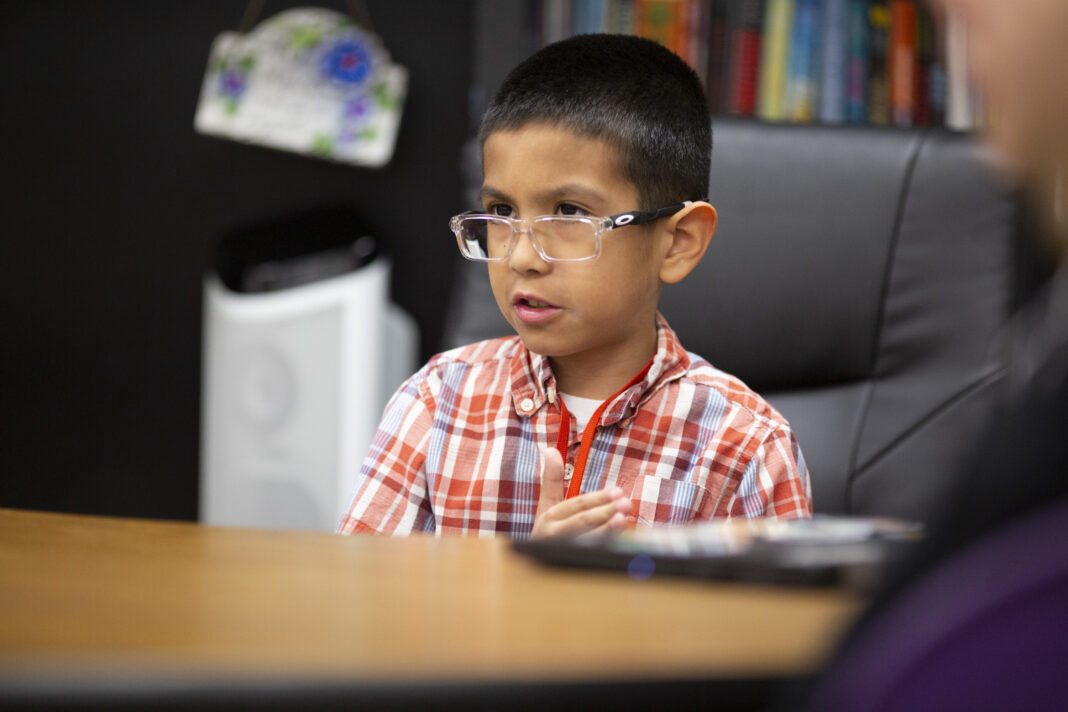In his first year as a gifted and talented teacher, David Cupp has found a way to engage his students through Minecraft Education Edition.
His classes at Gale Pond Alamo STEAM Academy convene once a week according to grade.
LBJ Elementary School GT teacher Vanessa Brower introduced Cupp to Minecraft several years ago.
“… It was probably my second year at Alamo. And at the time, I wasn’t really sure how we could use it because that’s when we still had the desktop computers and only four at a time. … When I moved into GT, and even last year with science, I found a way for kids to explain what they learned because I feel if they can take ownership of it, they can definitely grasp the material if they’re able to show it and explain it,” Cupp said.
This year, to introduce his students to enigmas and unsolved mysteries, students were looking into the Marfa Lights.
The students’ end goal next semester is to create a product to demonstrate what they’ve learned.
“… I’ve done Google Slides for them to create a digital museum. And then we’ve done Adobe Spark where they had to create … a little video on what they’ve learned; then we’ve done Minecraft. And then last week, they created … a digital breakout room and they were having to make digital clues. That way, when you are playing the game, you had to find the information and learn about it to get your code to escape out. I tried to make it more of they don’t learn the way we do anymore, so you have to find that way to engage them and hook them in,” Cupp said.
“Minecraft definitely is their hook. …,” he added.
This is Cupp’s eighth year of teaching. He was at Cameron Dual Language Elementary for a year, but the rest has been at Gale Pond teaching various grades. This is his first year as a GT, or Scholars in Progress instructor.
The Minecraft Education Edition allows teachers to create lessons that are already there, or create a world and have students build in it to show what they’ve learned.
Cupp said he has noticed that the game makes it easier for students to understand difficult concepts.
“… They had like a 45-minute time in that class to build that Minecraft and so we kind of were able to talk about if they decided to do this for their main product. How would you do it, because it can’t just be like a one room. So they’re already planning and thinking of how to explain their enigma, which they have their choice of Bigfoot, or Loch Ness Monster, or their pyramids. So they have this huge range to display their knowledge. And they’re definitely engaged. …,” he said.
Even over Christmas break, students are planning to keep working.
“It’s motivating them,” Cupp said.
Teaching about 47 total students, Cupp added that the students don’t realize that they’re learning.
As a side benefit, students also learned vocabulary words like enigma, ponder what an unsolved mystery is and whether they were a skeptic or a believer.
Cupp said he has learned as much from his students as they’ve learned from him.

Avyelle Puente, a 10-year-old fifth grader, Cody Bauer, an 11-year-old fifth grader, Nathan Ponce, a 9-year-old fourth-grader and Aubrey Heisler, a 10-year-old fourth grader, are all enjoying their journey into Minecraft for learning. They all play the game outside of class.
“When we were doing Minecraft to show some of the themes that we’ve learned, we were making these museums so it was like, we were using our creativity while we were sure trying to show what we’ve already learned,” Bauer said.
“Sometimes it can make a lot more fun to learn and easier to understand,” Bauer added.
The students enjoy learning this way for a variety of reasons.
“It’s a fun way to use your mind … It gives you many different kinds of resources and better ways,” Ponce said.
Heisler said she likes that they can show your creativity without anybody judging you.
“Because in GT, you’re here to think different than others,” she said.
Puente said when they are in class, “It’s like an explosion of ideas come to your mind. And it’s like other people give you ideas and ideas and so then we’re on Minecraft and we just make all these ideas and put them together and it makes a wonderful creation. So that’s what I like mostly about being in GT,” Puente said.
Since the class is once a week, the students really look forward to it. Cupp said they are in different grades and different classrooms, so they liked meeting each other.
Ponce said when he first started in GT, he started Scratch Jr. Then he went to “the real Scratch” and started experimenting with that.
Scratch is a way to introduce students to programming, Cupp said.
“Now here I am with two different accounts on Scratch and making games and all that with coding,” Ponce said.
Ponce said he has made several different games.
“I made a profit game and then I’m doing animations; some other stuff I’m working on. I’m working on a ‘Choose Your Own Adventure.’ It’s probably going to take me a few months to make because I want to add a lot of endings. I think I started in September. It’s just called A Game. That’s all it’s called,” Ponce said.
The profit game teaches you about expenses.
“I made that one just for fun,” he said.
Ponce said he may become a game designer, teacher or go into IT.
Bauer said he feels the class teaches them with certain careers for their futures.

“They teach us skills here that some teachers don’t teach in their normal classes,” Bauer said.
Puente said what she really likes about GT is that the people are so nice and you can really express yourself. She added that the ideas will keep coming and it will help her as she makes her way through high school.
Heisler said she thinks GT will help her in her future career, as well. She agreed that the people are nice. “And they don’t even care if I do something wrong, or if I show more creativity than them, or something like that because they already know GT is to express your feelings and to think different,” Heisler added.
The students had not heard about the Marfa Lights before they started the class, but it caught their attention.
Bauer said when he found out about the lights, “I wanted to dig deeper and kind of … figure out as much as I could about them so I could try and research and help figure out what causes them.”
Bauer said he thinks he has a theory about that. He said people see the lights at sunrise and sunset.
“… Maybe it’s like clouds of dust that’s reflecting the sun’s light. Because sometimes whenever light shines through a window, you can see dust particles floating around, so I was thinking what if it’s big clouds of dust reflecting the sun’s light?” he said.




